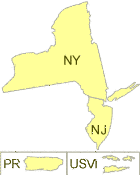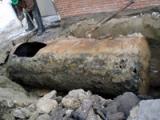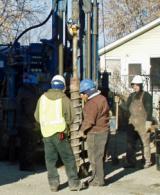Brownfields and Land Revitalization in New Jersey, New York, Puerto Rico, and the U.S. Virgin Islands
Welcome to the Brownfields Program website for the United States Environmental Protection Agency in Region 2. This website includes Brownfields Program information, which pertains to New York, New Jersey, Puerto Rico and the Virgin Islands.
- Materials for Brownfields Grants
Upcoming Events in Region 2
Event
Date
Location
Description
Contact
ARC Training
To be announced.
To be announced.
This event is designed to provide training in the creation of Brownfields assessment, revolving loan fund and cleanup proposals.
To be announced.
Roundtable Meeting for NJ Grantees
To be announced.
To be announced.
To be announced.
To be announced.
Roundtable Meeting for NY Grantees
To be announced.
To be announced.
To be announced.
To be announced.
- Brownfields Site-Eligibility Requests
EPA R2 is currently handling all site-eligibility determinations. If you are a Brownfields cooperative agreement recipient (CAR) or an eligible entity planning to submit a request for Targeted Brownfields Assessment (TBA) work, you must fill out one of the forms below for the site of interest, as best you reasonably can. If you have a hazardous site, and you are a CAR, please fill out the property-approval form for hazardous sites and send it to your Project Officer. If you have a petroleum site, and you are a CAR, please fill out the property-approval form for petroleum sites and send it to your Project Officer. All TBA requests must be sent to Alison Devine at devine.alison@epa.gov. Please copy John Struble on your request, if it is for a petroleum site, at struble.john@epa.gov. EPA will review the document and inform you if the site is eligible.
Filename Source Property Approval Form - Hazardous(1 pg, 30 K) Excel file Property Approval Form - Petroleum(1 pg, 59 K) Excel file - Stories from Around the Region
SENECA NATION – Seneca Nation is using Section 128(a) Tribal Response Program funding to actively locate and identify brownfields and build an inventory of properties to determine areas of concern within its tribal lands. Most of this property information has come from the community’s historical knowledge of tribal lands. The tribe uses public meetings and announcements in its bi-monthly newsletter to inform and educate tribal members about brownfields efforts, and to ask for assistance in identifying former uses of abandoned or underutilized properties. The community identified several properties with past oil spills and provided valuable information regarding an historic rail yard property; the tribe’s Environmental Protection Department worked extensively with the community to determine the potential risk of contamination associated with this former rail site. Tribal environmental staff also used Section 128(a) Tribal Response Program funding to attend brownfields training sessions to broaden its knowledge regarding brownfields issues and tribal response programs. The tribe has prioritized the properties in its inventory and used Section 128(a) Tribal Response Program funding to assess these sites and prepare them for cleanup.
VIRGIN ISLANDS – To operate and expand its brownfields program, the Virgin Islands (VI) continue to make progress to establish a Voluntary Cleanup Program (VCP), which will address the cleanup and/or redevelopment of brownfield sites within the VI. The VCP will be designed to return brownfield sites to useable condition. Cleanup will be performed under a memorandum of agreement between the Department of Planning and Natural Resources-Division of Environmental Protection (DPNR-DEP) and the participant. Following the enactment of the VI Brownfield Revitalization and Environmental Restoration Act in 2008, the program is finalizing the signatures for the promulgation of its final drafted rules and regulations. DPNR-DEP used its Section 128(a) Response Program funding to inventory 141 sites and assess 20. Currently, the program is seeking a professional services contractor to assist the division with conducting Phase I assessments.
PUERTO RICO – The Puerto Rico Environmental Quality Board (EQB) is using Section 128(a) Response Program funding to establish a Voluntary Cleanup Program (VCP). The EQB continues to make progress toward the VCP by focusing on the identification, redevelopment, revitalization, and cleanup of brownfields in Puerto Rico. One of the initial tasks performed under the cooperative agreement was the development of a brownfields inventory. To streamline the efforts needed to complete the inventory, EQB reached out to the 15 municipalities in Puerto Rico that currently have EPA Brownfields Community-wide Assessment Cooperative Agreements to request copies of their completed brownfields inventories. The EQB used these examples to develop an electronic state-wide brownfields inventory to provide valuable site information to the EQB and other government entities.
ST. REGIS MOHAWK TRIBE – Like the Mohawks of Akwesasne, the Ramapough Indian Nation are a strong people in the face of adversity. In the fall of 2007, the Ramapough Nation made its initial visit to the St. Regis Mohawk reservation to meet with the St. Regis Mohawk Tribe’s (SRMT) Environment Division Brownfields Program. The Ramapough Nation land, located on the New Jersey and New York border, was contaminated by toxic paint sludge from the neighboring industrial facility. The Ramapough Nation gathered information from the SRMT’s Environment Division regarding how to address contamination, health effects, cultural losses, and the struggle to overcome these obstacles. During this initial visit, the Environment Division shared information and visited with the community to talk about their experiences living next to an industrial landfill. In April 2014, the Ramapough Nation returned to the SRMT reservation to share their success story and how they fought for their land and health by working with the industrial facility to clean up the contamination. In June 2104, members of the SRMT used Section 128(a) Response Program funding to visit the Ramapough Nation to tour the successful redevelopment of the property into a large community medicine garden and to attend their “Healing of the Earth Ceremony.” The collaboration between SRMT and the Ramapough Nation is a wonderful example of how tribes can stand strong against environment contamination while staying true and protecting their culture for future generations. The SRMT Brownfields Program hopes to continue its relationship with the Ramapough Nation and apply what they learned to their own brownfields properties in Akwesasne.
Abraham Wing Elementary School
Spill Response Program Site Number: 1009793
An underground storage tank failure at the Abraham Wing Elementary School in Glens Falls, NY caused the subsurface release of an estimated 500 gallons of fuel oil. The Glens Falls fire company responded to the report and called in the spill to the New York State Department of Environmental Conservation (NYSDEC) after oil started bubbling up in a neighbor's basement sump and staff began noticing petroleum odors in the school. Fuel oil contains toxic chemicals, including benzene which may cause negative health effects in children and adults, including cancer, if exposures are great enough.
NYSDEC has a CERCLA 128 (a) grant to oversee the cleanup of environmental sites in New York State.
Over the first two weeks of the spill response, the 1,000 gallon underground storage tank and excavated contaminated soil were removed from the school. In addition, a groundwater treatment and vapor mitigation system was established at the impacted residence and a vapor mitigation system was established in the school. By March of 2011, a multi-well groundwater treatment system was established on the school property to gain further control of and remediate the oil plume. Today, the site is in operation and maintenance status. Through this work, the children and employees in the school, along with a neighbor, were protected from the potentially toxic effects of a hazardous spill.
- Highlights & Publications
- Green Infrastructure Barriers and Opportunities in Camden, New Jersey
- EPA Region 2 Presentation on Developing FY16 Brownfields Assessment Proposals(150 pp, 5 MB, October 2015)
- EPA Region 2 Presentation on Developing FY16 Brownfields Cleanup Proposals(173 pp, 5 MB, October 2015)
- EPA Region 2 Presentation on Developing FY16 Brownfields Revolving Loan Fund Proposals(150 pp, 4 MB, October 2015)
* Important Note: The above presentations serve as overviews on how to prepare grant proposals and should be used in conjunction with the guidelines. EPA Region 2 urges proposal writers to review the guidelines that can be found at Apply for Brownfields Grant Funding
State Cleanup Programs within Region 2



